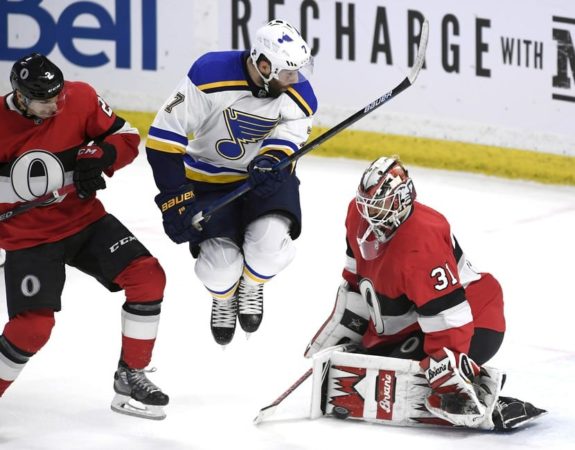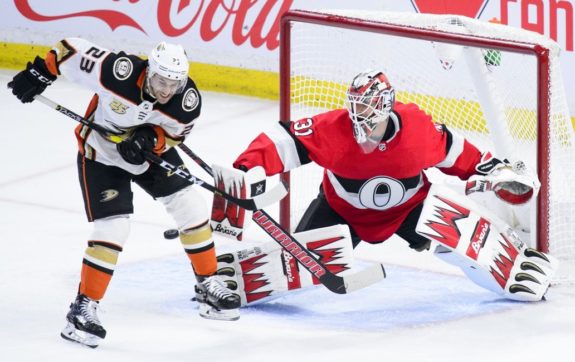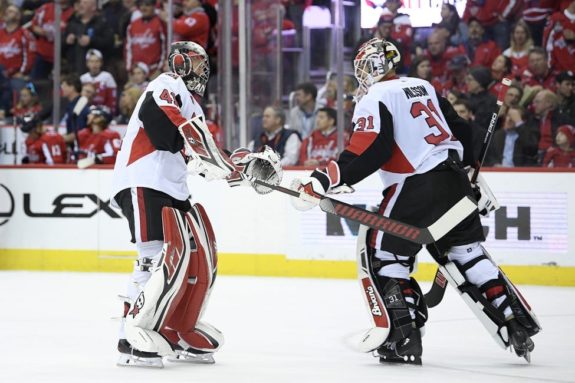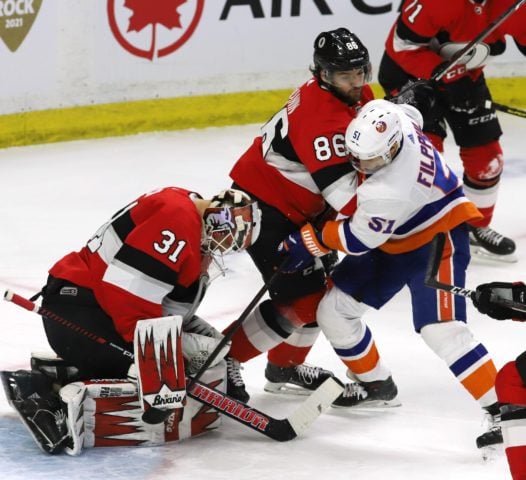Anders Nilsson was selected 62nd overall by the New York Islanders in the 2009 NHL Entry Draft. Since then, he has yet to solidify his role as anything more than a backup goaltender. While he has displayed flashes of elite goaltending abilities at times, his inconsistency has always led to him fighting to land his next NHL contract.
At 29 years old, the Senators are the sixth NHL team that Nilsson has played for. However, his recent two-year contract extension with the Senators has given him the opportunity to land the first starting goaltender role of his career. This begs the question; has Nilsson finally found stability with the Senators?

Nilsson’s Stats Improved Drastically Post-Trade
Prior to Nilsson’s arrival with the Senators, his stats were abysmal. After starting in 12 games for the Vancouver Canucks, he found himself with a record of 3-8-1, a goals-against average (GAA) of 3.09, and a save percentage (SV%) of .895. But, after being traded to Senators on Jan. 2, he put up some of the best stats in his NHL career. In 24 games with the Senators, he posted a record of 11-11, a GAA of 2.90, and a SV% of .914.
“I’m just trying to do my job when I get the chance, no matter whether it’s back-to-back starts or if it goes five games in between. My job is always the same, I just try to stop the puck.” – Anders Nilsson
From: ‘SNAPSHOTS: Anders Nilsson has stepped up for Senators’ – Ottawa Sun – 02/10/2019
The penalty kill (PK) is an important factor to look at when analyzing Nilsson’s post-trade statistics. During his time on the Canucks, Nilsson’s SV% on the PK was a mere .769. In his 22 games with the Senators, his SV% on the PK was a much better .889. For comparison, this was a higher SV% on the PK than notable goaltenders such as Pekka Rinne (.861), Tuukka Rask (.878), and Brayden Holtby (.827).

Nilsson as Senators’ Starter?
Following the 2019 NHL Trade Deadline, Guy Boucher was relieved from his duties as head coach. Marc Crawford was named interim head coach, and was ready to make long anticipated changes to the lineup. One of these changes was increasing minutes for players who displayed good on-ice performances, instead of allotting their time based on age, contract, or past capabilities. Nilsson benefited from this decision.
Down the stretch, he found himself getting an increasing number of starts in comparison to what an average NHL backup would receive. Over this span, his strong play proved why the starting goaltender role wasn’t locked down by long-time Senators goalie, Craig Anderson.
From March 1 on, Anderson started in 10 games but was pulled in the final game of the season. During the same time span, Nilsson started in seven games, taking over in the final game of the season when Anderson was pulled in the first period against the Columbus Blue Jackets. Anderson faced 349 shots over this span, allowing 33 goals against for a .905 SV% and a record of 3-6-1. Nilsson faced 271 shots in this span, allowing 19 goals for a .929 SV% and a record of 4-3-0.
From: ‘Nilsson comes up big, kids look just fine as Sens knock off Blues ‘ – Ottawa Citizen – 03/15/2019
“I thought our goalie was our best player and he was the main reason we got the win…He’s played very well and I thought he’s played some games where he’s been the most important factor in some of the wins that he’s had.” – Marc Crawford on Anders Nilsson’s play following a 2-0 shutout win against the St. Louis Blues
Another interesting statistic that sets Nilsson apart from Anderson, is his
goals saved above average (GSAA). This stat is essentially the plus/minus stat, but for goaltenders. It’s calculated by combining the league’s average SV% and the number of shots a goalie has faced. A positive GSAA means that the goaltender being analyzed has prevented that many more goals than the league average. A negative GSAA means that the goaltender is allowing more goals than the league average goalie would.
Anderson’s GSAA over this season was minus-11.94. On the other hand, Nilsson’s GSAA during his time on Ottawa was plus-3.15. This was similar to starting goaltenders like Holtby (plus-3.01) and Rask (plus-2.64). While the sample size of Nilsson’s stats in Ottawa has been relatively small, he has made a strong case as to earning the starting role to begin the 2019-20 campaign.

Nilsson has Minimal Competition in Ottawa
The Senators are in a transitional phase when it comes to their goaltending depth chart. As stated previously, Nilsson has a strong case to take the reins away from Anderson as the starting netminder for the Senators. Aside from Nilsson and Anderson, the Senators have the rights to, or have under contract, goaltenders Mike Condon, Marcus Högberg, Filip Gustavsson, and Joey Daccord. Mike Condon will most likely be either bought out this summer, if healthy, or placed on the LTIR for the 2019-20 season.
Related: Ryan’s Role in Senators’ Rebuild
Högberg is an RFA who is awaiting a contract and wasn’t outstanding in his three games for the Senators this season. If he signs a contract with the Senators, and Anderson is traded at the draft, then Högberg would have the best chance at becoming the Senators’ backup for next season, but he isn’t close to being ready for the starting role. Gustavsson and Daccord are the Senators’ top goaltending prospects.

However, both need a lot more seasoning in the AHL before they are ready to compete for a role on Ottawa’s roster. With Anderson declining and nearing the end of his career, Condon most likely not returning to the active roster, Högberg unsigned, and Gustavsson and Daccord needing time to improve in the minors, Nilsson finds himself with minimal competition over the duration of his contract with the Senators.
Nilsson has bounced around the NHL as a backup goaltender for the entirety of his career. In the sixth year of his NHL career, and already on his sixth NHL team, Nilsson seems to have finally found stability with the Senators. Over the next two years of his contract, he will have to prove that he’s capable of carrying the workload and pressures of a starting goaltender. However, his initial performances for the Senators have been promising, and he appears ready for the challenges that lay ahead.